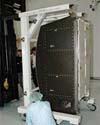| . |  |
. |
Houston TX (SPX) May 21, 2006 Jeff Williams, the International Space Station's current flight engineer, flew a miniature spacecraft around the pressurized Destiny module last week, NASA reported Friday. He was testing the flight control and autonomous docking characteristics that could be useful for eventually flying multiple full-scale spacecraft in formation. Known as SPHERES - for Synchronized Position Hold, Engage, Re-orient Experimental Satellites - the miniature spacecraft, developed over the last several years at the Massachusetts Institute of Technology, is a prototype for future satellite constellation and array spacecraft configurations. The technology also could be used to guide free-flying robotic assistants capable of helping astronauts on future spacewalks. For the first test of the SPHERES nanosat - which arrived aboard the station April 26 via a Russian Progress drone - Williams used the satellite and two beacons, one mounted and one hand-held. The satellite is eight inches in diameter and has a mass of about seven pounds (three kilograms). It also contains internal avionics, software and communications systems and maneuvers using compressed carbon dioxide gas thrusters. The first test flight consisted of a series of 10 to 15 pre-planned maneuvers, each lasting up to 10 minutes. After Williams selected and loaded the appropriate instructions on his laptop, the satellite began its pre-programmed maneuvers to test attitude control, station keeping, re-targeting, collision avoidance and fuel balancing. In other activities aboard the station, Williams and Pavel Vinogradov, the commander, began preparations for the expected visit by space shuttle Discovery, whose launch remains targeted for July 1 through 19 - and which is scheduled to bring the second SPHERES miniature satellite. Also last week, Vinogradov reconfigured ventilation lines associated with the Elektron oxygen generating system in the Zvezda module in preparation for a June 1 spacewalk. One of the spacewalk tasks will be to install a new external hydrogen vent line for the Elektron. Oxygen is being provided via storage tanks in the Progress supply vehicle. The Elektron will remain deactivated until after the spacewalk. Earlier in the week, the carbon dioxide removal system known as Vozdukh in the Russian segment malfunctioned. Flight controllers activated the carbon dioxide removal system in Destiny until troubleshooting restored Vozdukh's operation. Both units will run in tandem until the crew can install a new gas analyzer in Vozdukh. Related Links SPHERES Space Station  Kennedy Space Center FL (SPX) May 19, 2006
Kennedy Space Center FL (SPX) May 19, 2006NASA's next shuttle mission will transport a new device that can provide up to 12 pounds of oxygen every day, enough to support six crewmembers aboard the International Space Station, or double the size of the soon-to-be-expanded crew. |
|
| The content herein, unless otherwise known to be public domain, are Copyright 1995-2006 - SpaceDaily.AFP and UPI Wire Stories are copyright Agence France-Presse and United Press International. ESA PortalReports are copyright European Space Agency. All NASA sourced material is public domain. Additionalcopyrights may apply in whole or part to other bona fide parties. Advertising does not imply endorsement,agreement or approval of any opinions, statements or information provided by SpaceDaily on any Web page published or hosted by SpaceDaily. Privacy Statement |